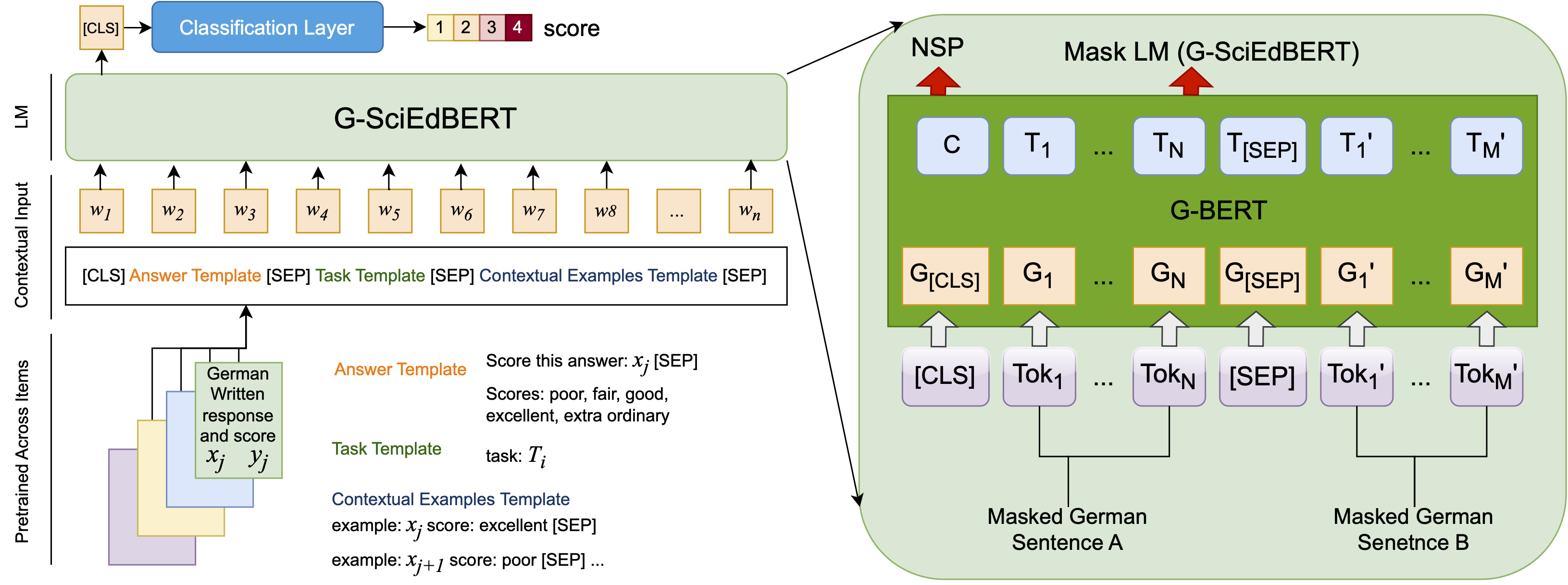|
--- |
|
license: mit |
|
language: |
|
- de |
|
metrics: |
|
- accuracy |
|
library_name: transformers |
|
pipeline_tag: text-classification |
|
tags: |
|
- Science |
|
--- |
|
## G-SciEdBERT: A Contextualized LLM for Science Assessment Tasks in German |
|
This model developed a contextualized German Science Education BERT (G-SciEdBERT), |
|
an innovative large language model tailored for scoring German-written responses to science tasks. |
|
Using G-BERT, we pre-trained G-SciEdBERT on a corpus of 50K German written science responses with 5M tokens to the Programme for International Student Assessment (PISA) 2015. |
|
We fine-tuned G-SciEdBERT on 59 assessment items and examined the scoring accuracy. We then compared its performance with G-BERT. |
|
Our findings reveal a substantial improvement in scoring accuracy with G-SciEdBERT, demonstrating a 10% increase of quadratic weighted kappa compared to G-BERT |
|
(mean accuracy difference = 0.096, SD = 0.024). These insights underline the significance of specialized language models like G-SciEdBERT, |
|
which is trained to enhance the accuracy of automated scoring, offering a substantial contribution to the field of AI in education. |
|
|
|
## Dataset |
|
It is a pre-trained German science education BERT for written German science assessments of the PISA test. |
|
PISA is an international test to monitor education trends led by OECD (Organisation for Economic Co-operation and Development). |
|
PISA items are developed to assess scientific literacy, highlighting real-world problem-solving skills and the needs of future workforce. |
|
This study analyzed data collected for 59 construct response science assessment items in German at the middle school level. |
|
A total of 6,116 German students from 257 schools participated in PISA 2015. |
|
Given the geographical diversity of participants, PISA data reflect the general German students' science literacy. |
|
|
|
The PISA items selected require either short (around one sentence) or extended (up to five sentences) responses. |
|
The minimum score for all items is 0, with the maximum being 3 or 4 for short responses and 4 or 5 for extended responses. |
|
Student responses have 20 words on average. Our pre-training dataset contains more than 50,000 student-written German responses, |
|
which means approximately 1,000 human-scored student responses per item for contextual learning through fine-tuning. |
|
More than 10 human raters scored each response in the training dataset organized by OECD. |
|
The responses were graded irrespective of the student's ethnicity, race, or gender to ensure fairness. |
|
|
|
## Architecture |
|
The model is pre-trained on [G-BERT](https://huggingface.co/dbmdz/bert-base-german-uncased?text=Ich+mag+dich.+Ich+liebe+%5BMASK%5D) and the pre-trainig method can be seen as: |
|
 |
|
|
|
|
|
## Evaluation Results |
|
The table below compares the outcomes between G-BERT and G-SciEdBERT for randomly picked five PISA assessment items and the average accuracy (QWK) |
|
reported for all datasets combined. It shows that G-SciEdBERT significantly outperformed G-BERT on automatic scoring of student written responses. |
|
Based on the QWK values, the percentage differences in accuracy vary from 4.2% to 13.6%, with an average increase of 10.0% in average (from .7136 to .8137). |
|
Especially for item S268Q02, which saw the largest improvement at 13.6% (from .761 to .852), this improvement is noteworthy. |
|
These findings demonstrate that G-SciEdBERT is more effective than G-BERT at comprehending and assessing complex science-related writings. |
|
|
|
The results of our analysis strongly support the adoption of G-SciEdBERT for the automatic scoring of German-written science responses in large-scale |
|
assessments such as PISA, given its superior accuracy over the general-purpose G-BERT model. |
|
|
|
|
|
| Item | Training Samples | Testing Samples | Labels | G-BERT | G-SciEdBERT | |
|
|---------|------------------|-----------------|--------------|--------|-------------| |
|
| S131Q02 | 487 | 122 | 5 | 0.761 | **0.852** | |
|
| S131Q04 | 478 | 120 | 5 | 0.683 | **0.725** | |
|
| S268Q02 | 446 | 112 | 2 | 0.757 | **0.893** | |
|
| S269Q01 | 508 | 127 | 2 | 0.837 | **0.953** | |
|
| S269Q03 | 500 | 126 | 4 | 0.702 | **0.802** | |
|
| Average | 665.95 | 166.49 | 2-5 (min-max) | 0.7136 | **0.8137** | |
|
|
|
|
|
## Usage |
|
|
|
With Transformers >= 2.3 our German BERT models can be loaded like this: |
|
|
|
```python |
|
from transformers import AutoModel, AutoTokenizer |
|
|
|
tokenizer = AutoTokenizer.from_pretrained("ai4stem-uga/G-SciEdBERT") |
|
model = AutoModel.from_pretrained("ai4stem-uga/G-SciEdBERT") |
|
``` |
|
|
|
# Acknowledgments |
|
This project is supported by the Alexender von Humboldt Foundation (PI Xiaoming Zhai, [email protected]). |
|
|
|
## Citation |
|
|
|
```bibtex |
|
@InProceedings{Latif_2024_G-SciEdBERT, |
|
author = {Latif, Ehsan and Lee, Gyeong-Geon and Neuman, Knut and Kastorff, Tamara and Zhai, Xiaoming}, |
|
title = {G-SciEdBERT: A Contextualized LLM for Science Assessment Tasks in German}, |
|
journal = {arXiv preprint arXiv:2402.06584}, |
|
year = {2024} |
|
pages = {1-9} |
|
} |
|
``` |
|
|
|
*This model is trained and shared by Ehsan Latif, Ph.D ([email protected]) |